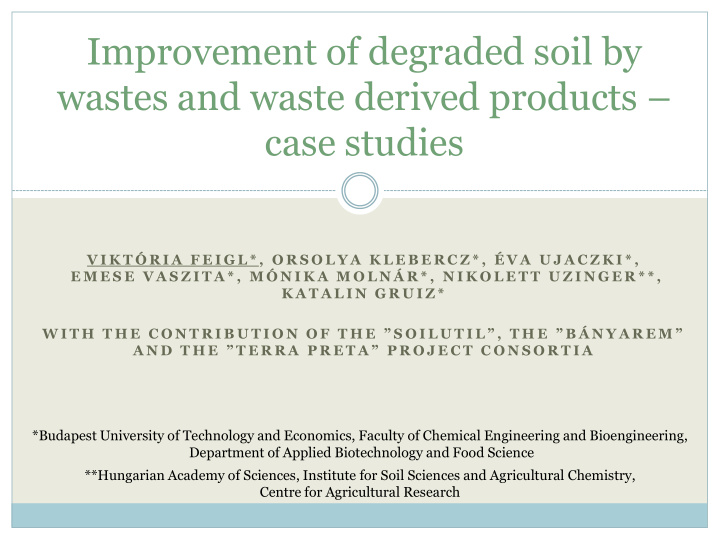



Improvement of degraded soil by wastes and waste derived products – case studies V I K T Ó R I A F E I G L * , O R S O L Y A K L E B E R C Z * , É V A U J A C Z K I * , E M E S E V A S Z I T A * , M Ó N I K A M O L N Á R * , N I K O L E T T U Z I N G E R * * , K A T A L I N G R U I Z * W I T H T H E C O N T R I B U T I O N O F T H E ” S O I L U T I L ” , T H E ” B Á N Y A R E M ” A N D T H E ” T E R R A P R E T A ” P R O J E C T C O N S O R T I A *Budapest University of Technology and Economics, Faculty of Chemical Engineering and Bioengineering, Department of Applied Biotechnology and Food Science **Hungarian Academy of Sciences, Institute for Soil Sciences and Agricultural Chemistry, Centre for Agricultural Research
Evaluation of wastes and their application for soil based on their risks and benefits Values and benefits Nutrient and organic matter content, pH Hazard of New, improved soil waste and the Re-use of waste Green areas: aesthetic, climatic, ecological risk of its application Value of the wastes and Hazards and risks Toxic substance content benefit Radioactivity of their Patogenes utilization Natural dilution Land use Frequency of application Untreated degraded land
Case studies: wastes for soil improvement No. 1. Remediation of mine waste with fly ash and other amendments No. 2. Remediation of metal contaminated soil with fly ash No. 3. Revegetation and rehabilitation: creation of a fertile topsoil layer from fly ash and organic wastes No. 4. Soil substitute from red mud No. 5. Acidic sandy soil improvement with biochar
Mine waste Environ- dump Metal ore Case study No 1. mental effect mine waste to be treated Nagyvölgyi creek Site: Gyöngyösoroszi mining site Problem: acidic (pH=2.8), Combined chemical and Chemical Chemical Cd, Zn, Pb and As containing stabiliser stabiliser pytostabilisation mine waste on the surface for 40 years Solution: combined chemical and phytostabilisation Amendments: Field experiment fly ash, lime, iron grit Plants: Fly ash + lime treatment grass mixture, broom corn, Fly ash sudan grass Untreated plot
Effect of chemical stabilisation Leachate: Cd: 441 µg/l ( HQC : 5 µg/l)* → 0. 12 µg/l Zn: 89 079 µg/l ( HQC: 200 µg/l)* → 29.3 µg/l (Untreated mine waste, 2007 → Fly ash+lime+iron, 2009) Mine waste treated with fly ash Untreated mine waste and lime Grass: 0.16 mg/kg Cd (HQC=1 mg/kg)** 58 mg/kg Zn (HQC=100 mg/kg)** * B contamination level for underground water, 6/2009 (IV. 14.) KvVM- EüM -FVM joint decree ** Hungarian quality criteria for food and fodder, 44/2003. (IV.26.) FVM and 17/1999 . (VI. 16.) EüM decree
Case study No 2. Site: Gyöngyösoroszi Flooding in Mine waste mining site Gyöngyösoroszi in the Toka-creek Problem: agricultural soil 3D Contour Plot (distribution of the zinc in the hobby garden) 18 contaminated with Cd and 16 14 Zn by flooding 12 10 8 Solution: combined 6 4 2000 2 chemical and Distance from 1500 1000 0 500 0 10 20 30 40 50 60 (ppm) Widht (m) Direction Toka-creek phytostabilisation Sudan grass on untreated (left) and fly ash Amendment: treated (right) soil fly ash Cd: 3.00 mg/kg Cd: 0.902 mg/kg Plant: grass mixture, Zn: 348 mg/kg Zn: 104 mg/kg broom corn, sudan grass, maize
Case study No. 3. Site: .A.S.A. Hungary Ltd. municipal landfill site at Gyál Problem: steep ringwall with no vegetation – bad Barren ringwall aesthetic view, erosion of the municipal landfill Solution: in situ waste mixing Amendment: Eroded fly ash; wood ash; raw, ringwall digested and composted sewage sludge Plant: grass mixture
Long term effect of waste treatment (2.5 years) One-time treatment, but improvement from year to year Improvement in texture, nutrient-availability, biological activity No toxic effect Best option: organic+inorganic amendment together Field experiment Fertilizer Organic Inorganic Organic+ Grass on the organic + inorganic inorganic waste amended plot
Experimental Case study No. 4. plots Site: .A.S.A. Hungary Ltd. municipal landfill site at Gyál Plants grown Problem: cheap and fertile on the waste cover material needed mixtures Solution: soil substitute from waste Best combinations: o subsoil + 2% Ajka red mud Wastes: + 10% green waste or compost subsoil (construction waste) o subsoil + 20% red mud contaminated soil red mud (Ajka) red mud contaminated soil Soil substitute with ideal water balance, (removed after Ajka accident) available nutrient and organic matter compost, green waste, saw dust content, active microflora, Plant: grass mixture no toxic effect
Case study No. 5. Experimental field plots Site: Nyírlúgos , Biochar agricultural land Problem: acidic (pH=4.5) sandy (85 w/w% sand) soil Maize in pot Solution: biochar experiments amendment Biochar from waste: Best options: o 1% biochar Grain husks o 0.5% biochar + microbial soil inoculant Paper fibre sludge Improved plant growth & productivity, Pyrolysis: 500 ° C, 20 min higher pH, available K and P, water holding capacity, Plant: maize more active microflora & soil as habitat
Wastes are solution for degraded land! Thank you for your attention! E-mail: vfeigl@mail.bme.hu, mmolnar@mail.bme.hu More info: www.enfo.hu The experiments were carried out in the frame of the BÁNYAREM (GVOP 3.1.1-2004-05-0261/3.0), the MOKKA (NKFP-020-05 ) and the SOILUTIL (TECH_09-A4-2009-0129) Hungarian R&D projects, the TERRA PRETA (HU09-0029-A1-2013) Norway Grants project
Recommend
More recommend